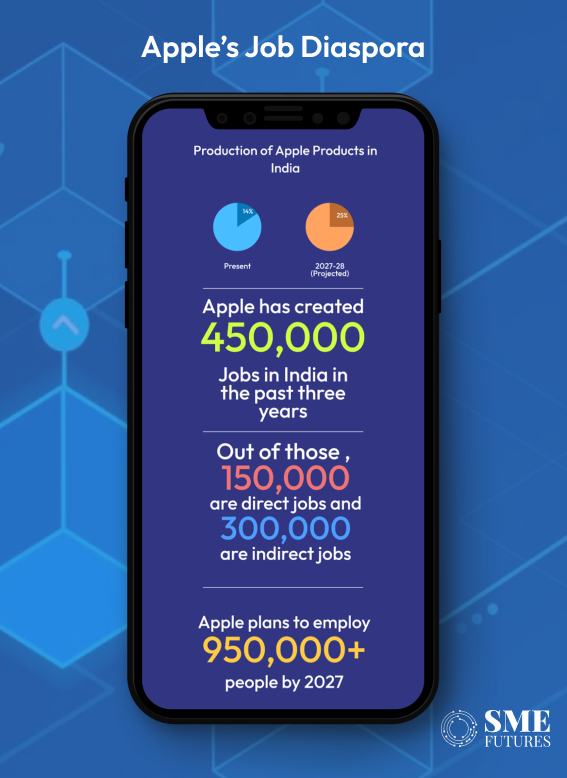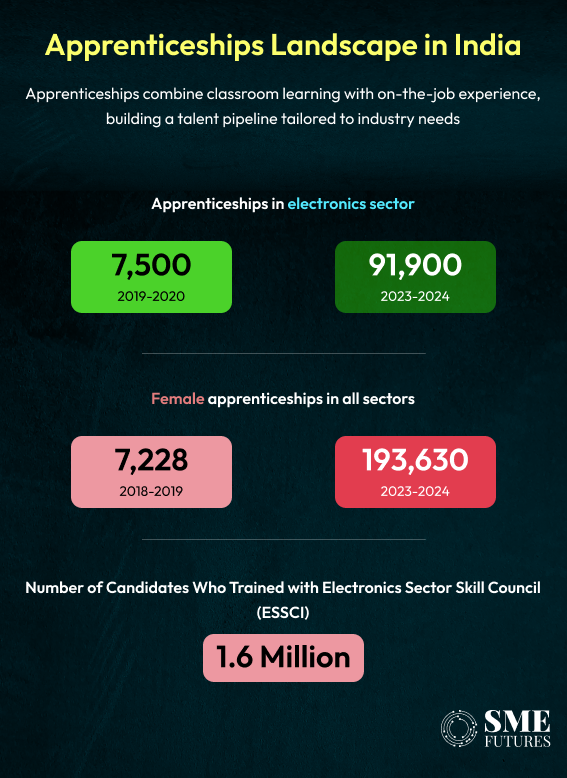In 2021, iPhone 13 took the Indian market by storm, representing nearly 80 per cent of the 5 million iPhones assembled and sold in the country. This achievement marked India’s entry into an elite club, joining China and Brazil in manufacturing Apple handsets with the iPhone SE (1st generation).
Fast forward to fiscal year 2024, and Apple Inc. has reached a staggering $14 billion worth of iPhone production in India. This means that Apple now produces about 14 per cent—or roughly 1 in 7—of its iconic devices in India. The surge of ‘Made in India’ iPhones is a testament to the country’s growing prowess in high-tech manufacturing.
The momentum continues into FY 2025, which has begun with a remarkable surge in iPhone exports from India. Recent data reveals that Made-in-India iPhone exports nearly doubled in April, soaring to $1.1 billion (Rs 9,000 crores) from $580 million a year ago. Experts predict that Apple will surpass the Rs 1 trillion export milestone in FY25, solidifying India’s status as Apple’s second-largest manufacturing hub outside China.
Consequently, Apple’s expanding manufacturing footprint in India is having ripple effects across the country’s economy. As the iPhone maker ramps up production of its marquee devices and assembles them locally, the tech giant’s growth is not only redefining the electronics industry but is also reshaping the job market.
The talent conundrum
Currently, the policy push, particularly the Production Linked Incentive Scheme, is making India a manufacturing hub for the electronics sector. If we talk about Electronics Manufacturing Services (EMS), which include mobile phone making, the market is expected to reach US$ 215 billion by 2025-26. Also, the sector roughly employs 12 lakh people, according to an ESSC India analysis.
However, with the growing market, this sector needs to employ over 6 million people by the end of 2025-26.
Now here comes the pertinent question; With 14-15% of Apple’s production already shifted to India and expected to increase to 24-25% by 2027-28, does India have the right talent to address the skills needed for this opportunity?
But let’s first see how the iPhone maker contributes to the job landscape.
The economic impact
The Apple ecosystem has experienced significant growth in India since the launch of the Production Linked Incentive Scheme, making it one of the country’s most significant job creators, particularly in the blue-collar sector.
Over the past three years, Apple has created over 1.5 lakh (150,000) direct jobs and 3 lakh (300,000) indirect jobs in India, positioning India as a strong alternative to China for both local sales and exports of Apple products.
As a result, India is poised to trigger a thriving supplier ecosystem, and could also become a potential R&D hub for software-to-silicon design, adding another layer of opportunity to the ecosystem.
Apple’s contract manufacturing ecosystem consists of Tata Electronics, Foxconn, Salcomp, Avary Technologies, CCL Industries, and Flex, among others. The job roles here span various functions, including assembly line workers, quality control inspectors and manufacturing engineers optimising production for efficiency and quality.

In addition to these roles, Apple’s supply chain growth in India will create job opportunities in logistics, procurement, and vendor management. Engineers of various disciplines, from mechanical to software, will be in high demand to support the ancillary functions.
Furthermore, every modern manufacturing plant relies on a robust IT infrastructure, creating opportunities for programmers, system analysts, and technical support personnel.
Therefore, Apple’s expansion plans could help generate 500,000 jobs in the next three years, considering the job creation in the ecosystem of suppliers and component makers. This bodes well for job prospects in the industry, especially through apprenticeships that mitigate the skill gap and create a sustainable talent supply chain.
Bridging the skill gap
Sumit Kumar, Chief Strategy Officer of TeamLease Degree Apprenticeship says that apprenticeship programmes can be a game changing solution to this problem.
“The electronics industry in India’s apprenticeship programmes can play a crucial role in bridging the skill gap between employers and the workforce. By combining classroom learning with on-the-job experience, apprentices gain practical knowledge while contributing to the company’s needs. This targeted approach helps build a talent pipeline tailored to specific industries, ensuring a steady stream of qualified workers,” he elaborates.
Apprenticeships are instrumental in bridging the gap between employment and employability by facilitating practical learning and providing on-the-job training.
Over the last four years, the electronics sector in India has seen a dramatic increase in apprentice engagement. From 7,500 apprentices in 2019-20, the number has skyrocketed to 91,900 in 2023-24—a 12.2-fold increase.
Apprenticeship–A pathway to inclusive growth?
How can apprenticeship help in mitigating skill challenges and aid Apple’s quest for growing Made-In-India phones, we ask.
Kumar summarises apprenticeship as a three-pronged strategy—It’s a pathway to formal employment; increase workforce productivity; and it’s a preferred pathway to create skill people.
According to him, the electronics industry is one of the largest employers of apprentices in India, contributing to apprentices’ participation reaching an impressive 9.3 lakhs under the NAPS (National Apprenticeship Promotion Scheme) scheme over the past three years. So, it’s natural that apprenticeships are the preferred pathway to create a skilled workforce for the electronics industry and the spillover of talented workers generated from the electronics industry will also help boost workforce productivity in other related industries.

“It underscores the effectiveness of policy reforms initiated under the ‘Skill India’ initiative, aligning seamlessly with the nation’s economic growth objectives. Moreover, the compelling Return on Investment (ROI) offered by apprenticeships has bolstered industry’s confidence in apprenticeships and has provided our youth with a pathway into formal employment, elevating their income levels,” he emphasises.
Furthermore, the Electronics Sector Skill Council (ESSCI) has aligned with the National Policy on Skill Development and Entrepreneurship (2015), training 1.6 million candidates across various domains. The industry’s commitment to investing in apprentices is evident, with average stipends exceeding prescribed levels by a remarkable 70% in pivotal job roles such as Smartphone Assembly Technicians and Assembly Line Operators.
Which again implies that there will be more job opportunities for apprentices in Apple’s assembly lines.
That said, apprenticeships play an indispensable role in nurturing talent, bridging critical skill gaps, and fostering inclusive growth across various sectors. This is further demonstrated by the remarkable rise in the number of female apprentices, from 7,228 in 2018-19 to 1,93,630 in 2023-24, promoting diversity within the workforce, empowering individuals from diverse backgrounds, and fostering innovation across various businesses and industries in the country.











